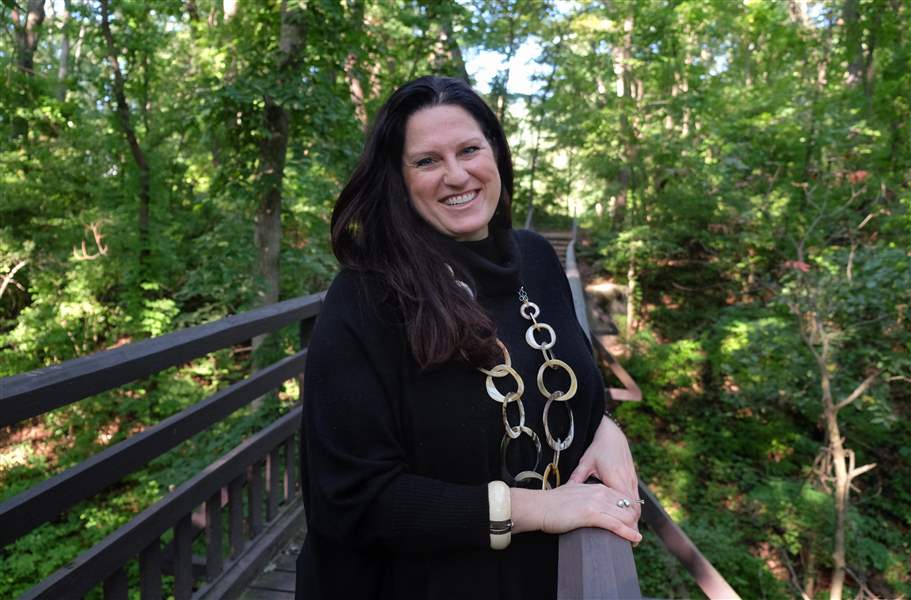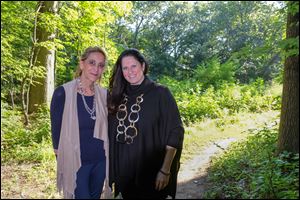
Medicine people continue ancient Native American traditions
8/31/2018
Deborah "Eagle Cloud" Ayres in Wildwood Metropark in Toledo, Ohio on August 23, 2018. Ayres is a Native American Medicine Woman.
The Blade/Jetta Fraser
Buy This Image
Deborah Ayres knew, on some level, that it was a bizarre interaction with a stranger.
“We were standing there next to each other, and I was taking note of him, because he had this incredible energy. And he looked at me and said, ‘Are you ready?’”
“The normal response when you’re hearing a story like that is, ‘For what?’” she said, thinking back with a laugh on the interaction that served as her introduction to Gene Rowe. ”But the way he said it and the energy that was behind it, my answer was, ‘I think so.’”

Deborah "Eagle Cloud" Ayres and Guldal Caba in Wildwood Metropark in Toledo, Ohio on August 23, 2018.
So began the journey of Deborah “Eagle Cloud” Ayres in Native American spirituality, guided first by Mr. Rowe, under whom she studied on a reservation in North Carolina after graduating Ohio University in 1996, and later by Guldal Caba, in Toledo, under whom she studied extensively before Ms. Caba ordained her a Native American medicine woman in 2016.
A medicine person is called to heal body, mind, and spirit in a sacred way, as Ms. Ayres and Ms. Caba explain; a medicine person aims to attune individuals to the divine light inside them — “their inner voice, God’s whisper in the heart,” as Ms. Caba characterizes it.
As she leans into this spiritual tradition in ceremonies and in individual sessions, as well as workshops and public speaking, Ms. Ayres, who runs an integrative healing practice locally, said she sees her work as particularly relevant in a modern-day context.
“We’ve spent centuries and centuries dissecting the human experience,” she said, putting mind sciences in one box, body sciences in another, religion and spirituality in a third. “And we’re so fractured now, especially in America. We’re in a movement where people are starting to bring it back together, and that’s why we are important right now. That’s our function.”
Neither Ms. Ayres nor Ms. Caba can definitively claim Native American heritage, although, in their tradition, that’s not a prerequisite to ordination as a medicine person. Ms. Ayres is ordained in the Sacred Circle Native American Church, an independent branch of the Oklevueha Native American Church that’s led by Ms. Caba. Ms. Caba, who counts the mother church’s founders as her teachers in the way that Ms. Ayres counts her as a teacher, explained that the Oklevueha Native American Church was organized around the idea that non-Native Americans, too, needed the healing afforded with this spirituality.
Ms. Ayres has long been drawn to Native American culture and spirituality, she said. When she left Toledo for Athens, Ohio, in the 1990s, she joined her college’s Native American coalition and for the first time began to meet individuals who were living the culture. Nearby Parkersburg, W.Va., she recalled, was home to a pan-Native American community that was happy to engage with the coalition students.
Through that community, she met a couple who invited her to the opening of a Native American art gallery in Parkersburg. In the powwow context of that celebration, she met Gene Rowe, in the mysterious manner that she and Ms. Caba said isn’t necessarily unusual in the context of indigenous tradition. She explained it in terms of the adage: When the student is ready, the teacher will come.
“Sometimes the student doesn’t know that’s happening,” she said. “Sometimes the student does.”
Ms. Ayres didn’t necessarily know what was happening when Mr. Rowe, whom she knew of but had never met, went on to tell her that he’d seen her in a dream. If she were ready, he continued, he would be her teacher.
“There wasn’t really any doubt in my heart,” she said. “This was a new chapter opening. I don’t know what it is, but I would be in betrayal of myself to say no.”
Ms. Ayres traveled to the Cherokee reservation in North Carolina after she graduated Ohio University to study under the medicine man, who would ordain her a pipe-carrier. She stayed in touch when she moved about a year later to Santa Fe, where she studied at the since-closed New Mexico Academy of Healing Arts and connected with the Native American communities there too.
That led to further learning experiences, like the Pueblo friend, for example, who taught her to collect sage for smudge bundles in the sacred and traditional way.
After a stint in Austin, Ms. Ayres returned to Toledo, where she met but did not immediately begin studying under Ms. Caba. Mr. Rowe had died by this point, meaning that she spent a few years without a teacher in the tradition where teachers, and teacher lineages, are key; a medicine person doesn’t simply declare himself or herself qualified.
Her integrative healing practice here began with massage therapy around this time, informed by but not explicitly incorporating the spirituality she’d picked up, she said. It’s since grown more holistic, so that she draws on the full scope of her medicines while interacting with a client.
Medicines in this context refers to the objects or skills that a medicine person has at her or her disposal. Each object — or representations of the more abstract skills — is kept in a medicine bundle, which a practitioner opens before he or she begins to work.
As a licensed massage therapist, Ms. Ayres, for example, counts body work among her medicine. She’s also a life coach. Ms. Caba is a psychologist and naturopathic doctor, giving her a slightly different expertise that’s applied toward the same purpose.
What exactly a medicine person does in working with a client one-on-one depends on the individual and the circumstances. Ms. Ayres explains that she “makes her bones hollow,” to borrow traditional language, meaning that she empties herself to “channel the light for the benefit of someone else.” Sometimes she’s drawn to healing through massage, other times through conversation, still other times through a ceremony involving a physical object in her bundle.
“Sometimes someone is on the [massage] table and it looks like they need to be smudged. So I smudge them,” she said, referring to ceremony by which sacred herbs are burned for spiritual cleansing. “Sometimes we’re just sitting her talking, and we never get to the table.”
Ms. Ayres said her schedule is routinely filled, speaking to a demand for this work. She’s also able to perform specific ceremonies, weddings, funerals, and home blessings.
She said it’s important work today and it’s exciting to see it in the context of a larger movement. As yoga goes mainstream and health food stores get traction, for example, she’s seeing an appreciation of the importance of holistic relationships of body, mind and spirit.
“We’re starting to bring these things back together.”
Contact Nicki Gorny at ngorny@theblade.com or 419-724-6133.